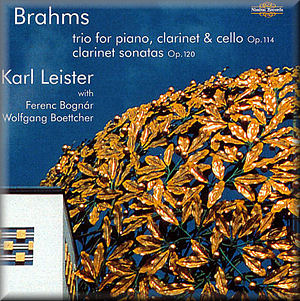 |
 |
| 
Buy
through MusicWeb
for £12 postage paid World-wide.
Musicweb
Purchase button
Sound Samples and Downloads |
Johannes BRAHMS
(1833-1897)
Trio for Piano, Clarinet and Cello, Op. 114 (1891) [25:31]
Sonata for Clarinet and Piano in F minor, Op. 120, No. 1 (1894)
[24:00]
Sonata for Clarinet and Piano in E flat major, Op. 120, No. 2 (1894)
[22:19]
 Karl Leister (clarinet); Ferenc Bognár (piano); Wolfgang Boettcher
(cello)
Karl Leister (clarinet); Ferenc Bognár (piano); Wolfgang Boettcher
(cello)
rec. Teldec Studio, Berlin, Germany, 12-16 February 1997. DDD
 NIMBUS NI 5600 [72:10]
NIMBUS NI 5600 [72:10] 
|
|
|
It is well known that Brahms had announced his retirement as
a composer, when he was so impressed by the playing of the Meiningen
Orchestra clarinetist Richard Mühlfeld that he produced four
of his greatest chamber works during the last years of his life.
The three works on this disc plus the Clarinet Quintet represent
the greatest music for the instrument after Mozart and Weber,
at least through the end of the nineteenth century. All four
compositions have that autumnal quality associated with late
Brahms.
Karl Leister is one of the world’s foremost clarinetists, having
performed for many years as principal clarinet with the Berlin
Philharmonic. In general, his tone is very mellow without the
stridency that is typical of some clarinetists. Yet it does
not preclude boldness when that is called for. He seems to me
the perfect soloist for these particular pieces. There have
been many recordings made with this combination of works, including
the recent one by Martin Fröst on BIS that has been widely praised.
In most cases, Leister’s tempos are slower than Fröst’s, but
in no way do I feel Leister is dragging. Indeed, for example,
the last movement of the Clarinet Sonata No. 1, marked vivace,
while slower than Fröst’s, has greater lilt, and Fröst sounds
rather rushed in comparison. Likewise in the same sonata’s third
movement (Allegretto grazioso), Fröst’s focus seems to
be on the allegretto marking, whereas Leister brings
out the grazioso element better. And so it goes throughout
the disc. The balance between clarinet and piano here is exemplary,
too, without the clarinet being recorded so closely that the
important piano part has to take a back seat. Brahms, after
all a pianist himself, always treated the piano as an equal
partner in his duo sonatas. Ferenc Bognár proves to be an excellent
Brahmsian, with clear articulation and appropriate weighting
of the bass notes. The Clarinet Trio is equally fine here, and
Wolfgang Boettcher is warmly expressive as the cellist. These
are truly beautiful performances, recorded very well in an intimate
acoustic and without noticeable reverberation.
Colin Lawson provides detailed notes in the CD booklet, with
the emphasis placed on the history of the works rather than
any in-depth structural analysis. For this particular combination
of chamber works featuring the clarinet, then, the performances
and recording here are as good as any I’ve heard.
Leslie Wright
|
|

